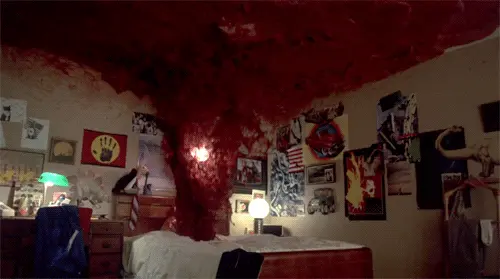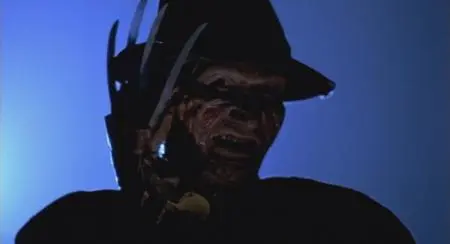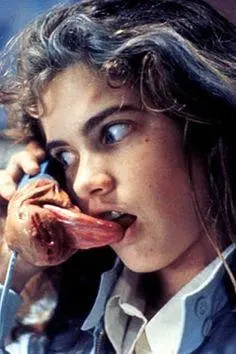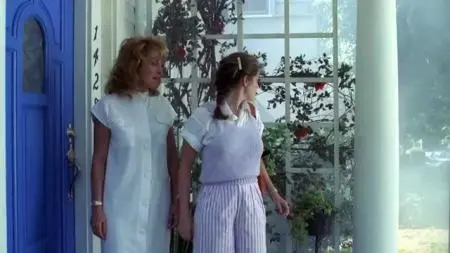Welcome back to What Works & What Doesn't. If you've been following this series of columns, you'll know we're poised to examine the dynamics of Act III, which occupies anywhere from 20 to 30 pages of your script and wraps the story up, even if—and this is important—the audience isn't necessarily "happy" with the results. In other words, as a screenwriter, do not strive for a happy ending to your story if one is not called for, based on the story elements you've set up in the previous acts.
Case in point: A Nightmare on Elm Street (the original, of course). If you're familiar with this film, you already know how the story ends, but if not, we'll get to a plot breakdown in a moment. As always, I'm providing the requisite SPOILER ALERT now, in case that wasn't obvious, but I'll also wag my finger at you for having not seen Elm Street '84—I mean, jam on it, already. It's 32 years old at this point, and now I feel really old.
Now, before we jump in to Elm Street itself, let's take a moment to get a better grasp on the inner workings of a solid Act III with some writing advice from a renowned screenwriting expert...
Act III Defined
If you're thinking I'm about to dip into Robert McKee's Story, your line of reasoning would be credible—I've referenced this text in every single WWWD column thus far—but you'd also be wrong. I've decided to shake things up this time around and turn instead to Syd Field, whose how-to book Screenplay: The Foundations of Screenwriting; A Step-by-Step Guide from Concept to Finished Script (or just Screenplay for short) is just as revered as McKee's Story, perhaps even more-so, depending on who you ask.
So, what does Mr. Field have to say about Act III, or more specifically, the resolution of a story? Quite a bit, actually, and his advice is especially pertinent to our discussion of Elm Street. Field theorizes that the best way to satisfactorily wrap up your story is to effectively know how the story ends even before you begin writing Act I. This is because screenplays are, by design, guided by a sense of direction. He writes:
...your story moves forward from point A to point Z, from set-up to resolution, and it doesn't matter whether it's told in bits and pieces of memory, as in The Bourne Supremacy; or in flashbacks, as in Cold Mountain, Annie Hall, or The English Patient; or in a straight linear story line as in The Pianist, Chinatown, Spider-Man 2 (Alvin Sargent), or The Matrix. Remember that the definition of screenplay structure is 'a linear progression of related incidents, episodes, and events leading to a dramatic resolution.'
That means your story moves forward from beginning to end.
Because of this, Field insists that before you can know how to begin your script, you have to know how it ends. This no doubt sounds counter-intuitive to the creative process, and opposite most writing advice you've ever heard—generally speaking, most writers will tell you to let the characters and outside obstacles steer you to the final moments of your story. And this is also solid advice, however, it is also advisable, once you've arrived at the ending, to go back and change the beginning and other moments throughout the narrative to better "prepare" your readers/viewers for the outcome—something I like to call leaving breadcrumbs, little hints and suggestions that subtly inform the audience what will happen, even if they're not wholly aware that is happening (which is of course ideal).
'Nightmare' Revisited
As I said above, this concept of knowing a story's resolution prior to the story's inception—or, if not that, shaping the story's beginning as well as sprinkling in those breadcrumbs of suggestion—is pertinent to our discussion of Elm Street. Why? Because, for many years now, I believed that writer/director Wes Craven failed to do this, to properly set us up for the ending—or more specifically, the final terror stinger that closes the film.
Now, let me qualify this statement by saying that I ADORE this film, even though I recognized a potential flaw in its storytelling structure. I even love (most) of the sequels, despite their more glaring problems.
Furthermore, let me admit that, for all these years, up until my re-watch of Elm Street for this very column you're now reading, I was completely WRONG about the absence of breadcrumbs in this film. I'm honestly a bit embarrassed I hadn't noticed them before now, as many times as I've watched this movie since first viewing it decades ago.
Okay, for those of you who are familiar with the film, you may know what I'm talking about at this point, or you might be about as lost as Nancy was when navigating Freddy's boiler room lair. So for anyone who's lost, and anyone who hasn't yet seen the film (jam the fuck on it, already), I give you the requisite, and very brief, plot synopsis (and the finer details are important, so bear with me):
Synopsis
The film starts with a nightmare. Freddy (Robert Englund) chases Tina (Amanda Wyss), a high school girl, through a labyrinthine boiler room. He almost catches her with his homemade claw glove before she wakes up in a cold sweat.
Later, telling of her nightmare to friends Nancy (Heather Langenkamp), Glen (Johnny Depp), and Rod (Jsu Garcia, as Nick Corri), she learns that they all had similar dreams the night before, though they brush it off as a coincidence.
Tina invites Glen and Nancy over to her house that night to help her feel safe (her mother is out of town). Rod crashes the party, and after having sexy time in her mother's bedroom with him, Tina falls asleep and once again dreams of Freddy, who is successful in killing her this time, in the film's decidedly most brutal kill sequence (she's dragged across the ceiling by an invisible Freddy as he slashes her to ribbons).
Rod, distraught, disappears, leaving Nancy, Glen and Nancy's cop father (John Saxon) to believe he killed Tina. He's eventually caught by the police and thrown in a holding cell. Meanwhile, Nancy dozes off in English class and dreams of Freddy, who very nearly kills her. She only escapes by burning her own arm on a pipe, thus startling her from the dream.
At home, she's once again attacked by Freddy when she falls asleep in the tub, and thus decides to begin taking caffeine pills and drinking copious amounts of coffee. This doesn't work, however, so she devises a plan with Glen, in which Nancy will fall asleep and he will watch her, to finally solidify her theory that Freddy is real. The plan works, though Nancy unfortunately has to watch as Freddy kills Rod in jail, which she could have stopped in real-life, but Glen dozed off too (this inability to stay awake for five minutes will come back around).They rush to the police station, but they are too late: Rod is dead.
Nancy's mother (Ronnee Blakely), believing something to be terribly wrong with her daughter, takes Nancy to a sleep institute, where they attempt to monitor her during R.E.M. sleep. It quickly becomes apparent she's in trouble, and the doctor's wake her up. Not only did she indeed meet Freddy again, but this time, she managed to bring his hat back with her into the real world. It even has his name written on the inside band, which makes her mother dodgy and nervous.
Nancy begins studying booby trap guides as she hatches the ultimate plan to catch Freddy. Glen, still not convinced anything supernatural is actually occurring, tells her the next time she has a nightmare, to turn her back on the thing that scares her, in order to take away its power of fear (and to simply embrace the dream and go into a "magic world").
Returning home, Nancy finds that her mother has put bars on all the windows, ostensibly to keep anyone dangerous from getting in. Nancy confronts her about the name Freddy Kruger, and her mother finally tells her the truth: Kruger was a child killer active when Nancy was younger. He was finally caught by the police, but was acquitted on a technicality. Thus, the neighborhood parents decided to take justice into their own hands, lock him into his boiler room lair, and burn him alive. Nancy's mom even kept Freddy's glove as a souvenir.
This solidifies Nancy's resolve, and she once again turns to sleepy-head Glen to help her catch Freddy, his one job being to stay awake and call her at a specific time. So what does he do? Puts on his headphones and passes out with his TV on his lap.

So yeah, he gets pulled into his own bed by Freddy and completely exsanguinated. Freddy calls Nancy on the phone, says the iconic line, "I'm your boyfriend now, Nancy," and sticks his tongue out through the mouthpiece (all while Nancy is wide-awake, mind you; remember this).
Now it's just up to Nancy. She sets her booby traps, goes to sleep, pulls Freddy into the real world, fucks his shit up old school, and burns him up again. Doesn't work, though, and Freddy uses his own burning body to turn Nancy's mother into burnt bacon. Fed up, Nancy decides to heed Glen's advice (he has to be useful for something, after all) and she demands Freddy give back her mother and friends, then turns her back on him. He vanishes into the ether mid claw-swipe, and Nancy finds herself outside, on her way to school, everyone she's lost alive and well.
Except...Turns out, Freddy is still in control of the dream, the stripes of his sweater appearing on the ragtop of Glen's convertible. The Freddy car drives Nancy and her friends off to ostensible doom, then Freddy's arm pulls Nancy's mom through the tiny window on the front door of her quaint Elm Street home.
Cue painfully '80s end credit rock theme.
Breadcrumbs
So, on that stinger ending. It always felt a bit tacked on to me. It seemed to be inconsistent with all the rules set up previously, and a subversion of the actual breadcrumbs left by Craven throughout the film, specifically Glen's speech about the "Balinese way of dreaming," whereby he advises Nancy to turn away from Freddy and rob him of his power to terrify her.
And indeed, this stinger was tacked on. According to the documentary Never Sleep Again: The Elm Street Legacy, producer Robert Shaye insisted on including more of a question mark at the end of the picture. Craven said Shaye's reasoning on this was to open the door for sequels, though Shaye insists it was because Craven's denouement—where Nancy finally wakes up to discover the preceding narrative had been nothing more than an elaborate nightmare, and she goes off to school with her friends, happy and content—didn't pack enough weight and, well, horror.
Craven is a master, to be sure, but I have to say, Shaye was right. Even if we look at the "nightmare isn't over" denouement as tacked on, it still works much better than the completely happy ending Craven devised, mostly because the "it was all a dream" ending is just so cliche, and likely wouldn't have held up as well over the years.
But here's what's really interesting: both the stinger ending and the happy ending reveal something key about Elm Street: the entire film is a dream. Moreover, even though this was never intended by Craven, there are actually numerous breadcrumbs that hint audiences to the nightmarish final minutes. Here they are:
Clue 1: The Jump-Roping Girls
Right after the nightmare scene that opens the film, when Tina talks about her dream in Glen's car, as they're pulling up to school, we first see a group of girls jump-roping in slow motion, dressed all in white (even the rope is blinding), singing the iconic "1-2 Freddy's Coming for You" song. There's this gauzy effect that makes the surreal scene look hazy. The camera pans over to the road, the film resumes normal speed, the sound of the girls' singing fades out, and the gauzy effect dissipates, at which point we can hear Tina discussing her dream, and even mentioning the old jump rope song.
One immediately thinks, okay, the visualization was nothing more than Tina's memory, "showing" us this old song, rather than telling it to us. But, these girls, the slow-mo, the gauziness, all return just after Glen's car turns into Freddy and rolls the teens toward prolonged terror at the end of the film, solidifying these figures as not part of Tina's memory, but rather part of "reality." Remember, the girls at the beginning transition into reality—i.e., they're shown to be a ghostly aspect of reality, rather than separate from it.
Clue 2: Literary Allusions
"What is seen is not always what is real," says the English teacher in the scene where Nancy dozes off and meets Freddy once again. If there is a more bold-faced indication that Nancy's supposed victory over Freddy at the end of Act III is not what it seems, I'd like to see it.
Furthermore, the quote is a line from Shakespeare's Hamlet, in which the titular character may or may not be insane. Furthermore, we see that Nancy has written her name on the side of her paperback copy of Hamlet, though the pages are rather splayed toward the top of the book. This splaying cuts into her last name, Thompson, representing the idea that she is deteriorating, splitting up the middle. This notion of madness will crop up again in further clues...
There's another literary allusion in this scene, in the form of a giant poster for the 1977 Lincoln Center production of Anton Chekhov's The Cherry Orchard, featuring the face of Irene Worth, who plays the lead matriarch Ranevskaya. I struggle to find concrete parallels between that play's narrative and Elm Street's. Perhaps the image of Ranevskaya represents Nancy's polar opposite, in that the former is at times infuriatingly languid in her resolve and motivations, while Nancy is all about getting shit done. Maybe the poster just looks cool. Who can say?
Clue 3: Madness
In the sleep institute scene, Nancy asks the doctor if she couldn't just take a pill that would keep her from dreaming. He effectively tells her every person has to dream, because "If you don't dream, you go." On the last word, he points to his temple, meaning the brain, meaning if you don't dream, you lose your mind. The same can be said for depriving oneself of sleep, which Nancy has been doing pretty much ever since Tina's death.
The question of Nancy's sanity crops up numerous times throughout the film, an idea promulgated primarily by her mother. And while Nancy insists her mind is still intact, we have to wonder: are her faculties really that sound? Could these nightmares of Freddy in fact be hallucinations spurred on by her rapidly deteriorating state?
One instance in the film seems to verify this: the phone call Nancy receives from Freddy while she is wide awake. Ostensibly this moment breaks the rules in favor of a gross (and awesome) special effects gag. How could Freddy attack Nancy if she isn't asleep? And the answer is, of course: she IS asleep, or perhaps in a kind of sleepwalking state, where reality and fantasy have blurred into one, incoherent and surreal landscape—i.e., madness.
What Works & What Doesn't
Overall, Elm Street works simply because it is so entertaining and watchable these 32 years since its release. The special effects hold up rather well, and the story is taut and engaging in a short span of time (just a little over 90 minutes). If you ignore the broader implications of the stinger ending, and the suggestion that the narrative is either a prolonged nightmare or a descent into madness, what you have is a fairly straightforward adventure plot, in which our heroine learns of an external evil (and internal, considering Freddy's ability to enter one's dreams) and fights tooth and nail to stop it, with the whole of Act III comprising the crafty Nancy's final confrontation with the ghostly baddie. She "wins," though in the last minute or so we have the rug pulled out from under us, as it is revealed she didn't win at all.
Again, ignoring any broader implications to this stinger, and instances of rule-breaking (Freddy harassing Nancy over the phone while she is wide-awake), Elm Street has a solid plot with a few flaws that don't take away from its overall quality. However, when we look closer at the narrative, and we consider that the entire film is basically a dream, we realize that there are no rules, that Freddy doesn't have to attack his prey when they're "sleeping," because technically, they're already asleep, and that the stinger ending doesn't subvert Nancy's supposed victory at all, because technically, she never won.
I know what you're thinking, so we'll end our discussion on this final point. The question is, if the entire narrative is a dream—which means Freddy is actually in control of EVERYTHING (the dreamworld is HIS domain, after all), why would Freddy effectively pretend to lose his battle? Why would he dissipate mid-attack after Nancy turns her back on him?
The answer is simple, and evidenced throughout the original Elm Street and all the sequels to follow: Freddy's an asshole. He loves to taunt his victims before executing his deathblow. In this way, letting Nancy think she's won, letting her walk out her front door under the pretense that everything is fine, that her friends and her mother are alive—it's all one big, taunting "FUCK YOU" before he drops his striped-rag-top self over Nancy's head. You even hear him laughing as the Freddy car slowly drives away.
What are your thoughts on A Nightmare on Elm Street? Even though much of the breadcrumbs I discussed were unintentional, do you agree that everything works out rather perfectly in the end, or do you still think—as I once did—that the telling of the tale is enjoyable, but nonetheless flawed? Let us know what you think in the comments section below.

About the author
Christopher Shultz writes plays and fiction. His works have appeared at The Inkwell Theatre's Playwrights' Night, and in Pseudopod, Unnerving Magazine, Apex Magazine, freeze frame flash fiction and Grievous Angel, among other places. He has also contributed columns on books and film at LitReactor, The Cinematropolis, and Tor.com. Christopher currently lives in Oklahoma City. More info at christophershultz.com











